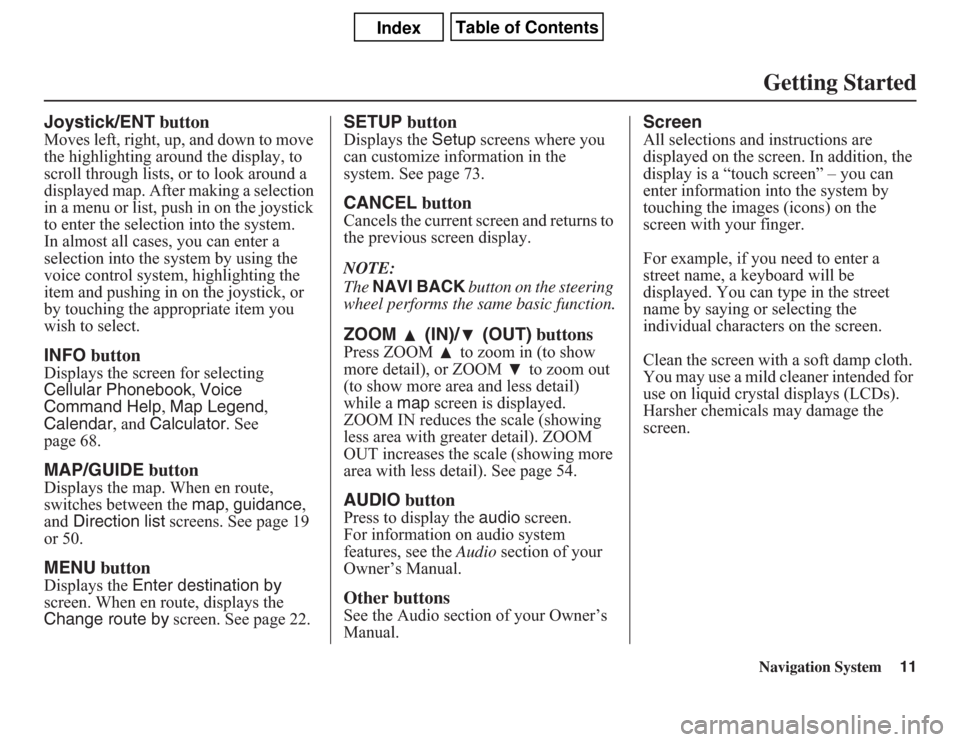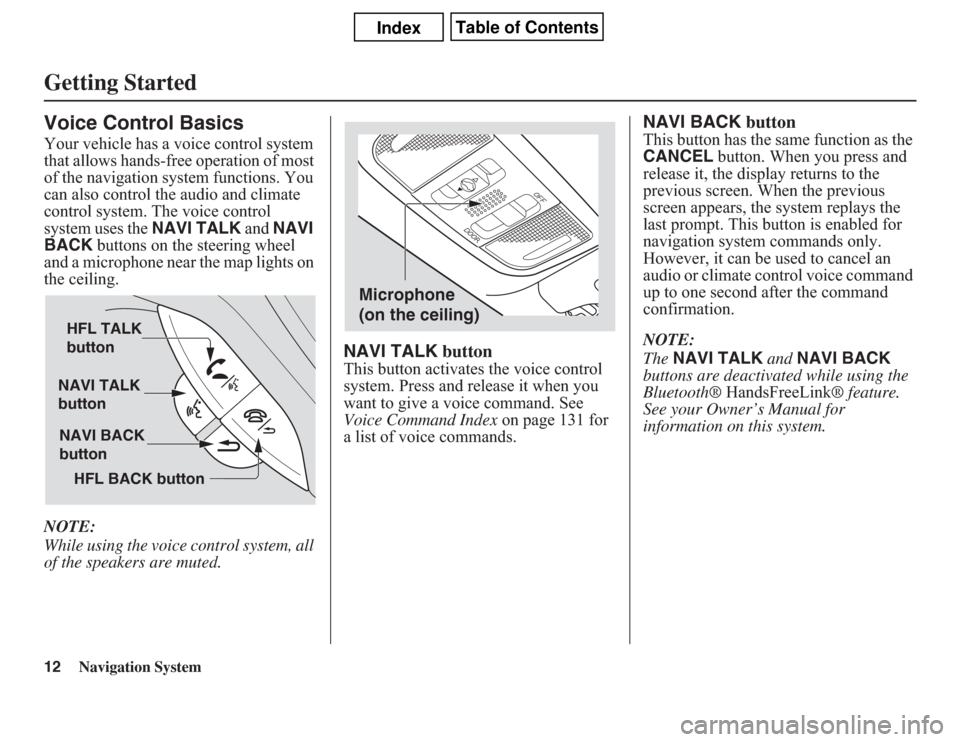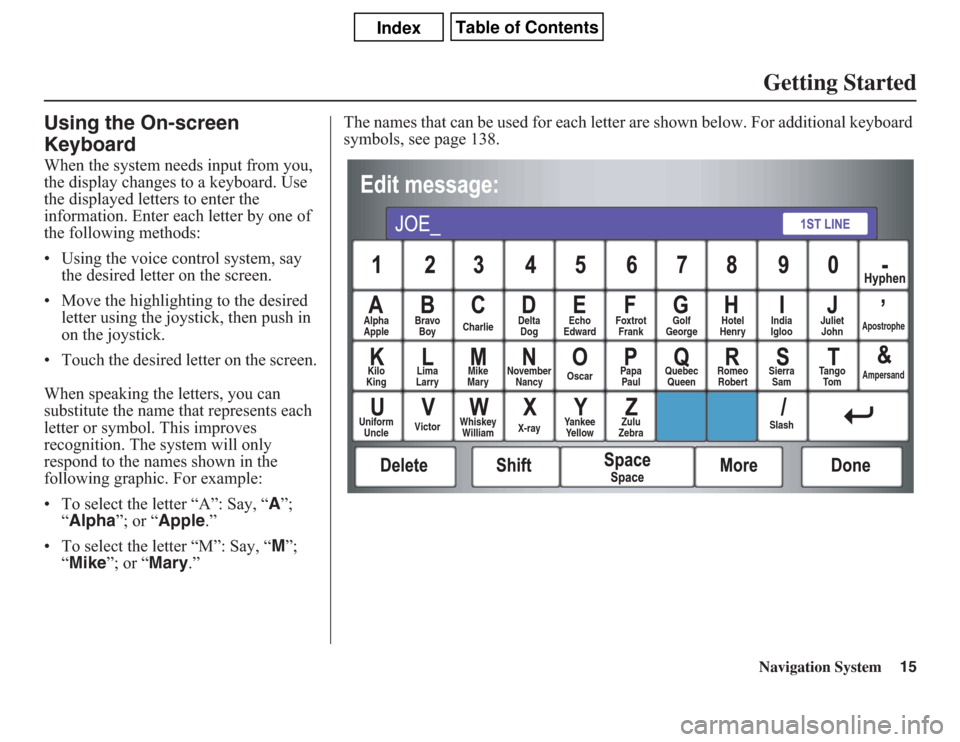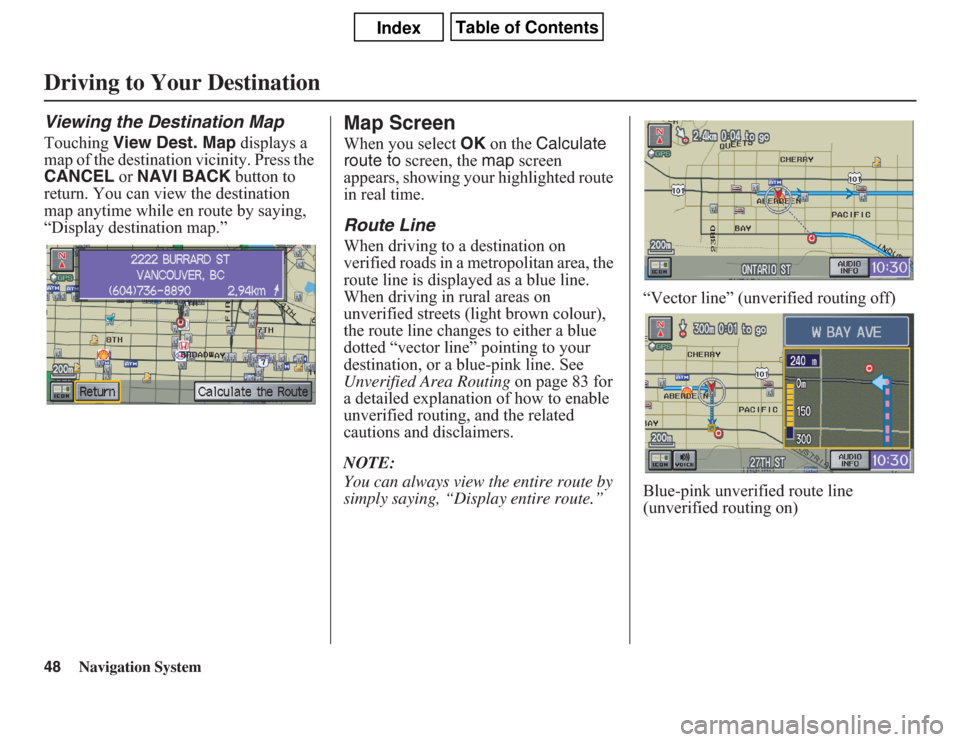2011 Acura CSX light
[x] Cancel search: lightPage 6 of 145

Navigation System
While driving, do not look at the screen
or operate the system controls for more
than a second or so at a time, and only
after deciding you can do so safely. Pull
to the side of the road if you need more
time to look at the screen or operate the
controls.The navigation system is designed to
provide route information to help you
reach your destination. However, this
route guidance may sometimes conflict
with current road conditions such as
street closures, road construction,
detours, and out-of-date map data.
Additionally, the system itself has
certain limitations (see page 98).
Therefore, you must verify the audio
and visual route information provided
by the system by carefully observing the
roadway, signs and signals, etc. If you
are unsure, proceed with caution.
Always use your own good judgment,
and obey traffic laws while driving.
Map OverviewCurrent StreetThe current street on which your vehicle
is located appears at the bottom of the map
screen (see page 19). A message
saying “Not on a digitized road” may
appear instead when you drive 800
metres away from a mapped road. For
more details, see
Off-road Tracking
on
page 60.
Verified/Unverified StreetYour navigation system has two kinds
of streets: verified (dark coloured) and
unverified (light coloured). The
differences between the two types of
streets are contrasted in the chart on
page 7. Note that the “Unverified” roads
are displayed only on the U.S. areas.
Using the navigation system
while driving can take your
attention away from the road,
causing a crash in which you
could be seriously injured or
killed.
Only operate system controls
when the conditions permit you
to safely do so.
WARNING
“Unverified” Road
“Verified” Road
Introduction6
Page 7 of 145

Navigation System7
Introduction
Verified streets (dark coloured) Unverified streets (light coloured)
When
displayedThese roads are found within metropolitan areas, and
include interstate highways and major roads
connecting cities.These roads are found in rural areas, and typically include
residential streets away from the centre of a town.
Street colourShown on daytime map screen as black or red, such as
interstate highways.Shown on the daytime map screen as light brown.
Map qualityThe database vendor has verified these streets.
Information like turn restrictions, average speed, and
whether it is a one-way street have been gathered and
used when creating your route to a destination.These streets have not been verified by the database vendor. The
system does not contain information on one-way streets, turn
restrictions, or the road’s average speed. They are shown on the
map for reference and way have errors in map location, naming,
and address range.
Routing
differencesWhile driving to your destination, the displayed route
line is solid blue. The system provides voice and map
guidance to your destination.Your route line is either a blue dotted “vector line,” or a dashed
pink/blue line. For information on selecting this option, and the
routing differences, see Unverified Area Routing on page 83.
CautionsThere are no pop-up boxes urging extra caution during
a route. However, because roads constantly change,
you are urged to use common sense, and always obey
posted traffic restrictions.Regardless of whether the user chooses route guidance, there are
cautionary screens before and during the route urging the user to
be extra cautious, and obey all traffic restrictions. See Unverified
Area Routing on page 83.
Guidance
voiceVoice guidance issues instructions such as “In 500 m,
make a right turn.”The phrase “if possible” is added to each guidance instruction.
For example: “In 500 m, make a right turn, if possible.”
Time and
distance
“to go”The time and distance “to go,” displayed while en
route to a destination, is based on the average speed
and distance for the roads used for your route.Because the average speed of these roads is not known, the time
and distance “to go” is based on a fixed average speed of 40 km/h
for these roads.
Page 11 of 145

Navigation System11Getting Started
Joystick/ENT buttonMoves left, right, up, and down to move
the highlighting around the display, to
scroll through lists, or to look around a
displayed map. After making a selection
in a menu or list, push in on the joystick
to enter the selection into the system.
In almost all cases, you can enter a
selection into the system by using the
voice control system, highlighting the
item and pushing in on the joystick, or
by touching the appropriate item you
wish to select.INFO buttonDisplays the screen for selecting
Cellular Phonebook, Voice
Command Help, Map Legend,
Calendar, and Calculator. See
page 68.MAP/GUIDE buttonDisplays the map. When en route,
switches between the map, guidance,
and Direction list screens. See page 19
or 50.MENU buttonDisplays the Enter destination by
screen. When en route, displays the
Change route by screen. See page 22.
SETUP buttonDisplays the Setup screens where you
can customize information in the
system. See page 73.CANCEL buttonCancels the current screen and returns to
the previous screen display.
NOTE:
The NAVI BACK button on the steering
wheel performs the same basic function.ZOOM (IN)/ (OUT) buttonsPress ZOOM to zoom in (to show
more detail), or ZOOM to zoom out
(to show more area and less detail)
while a map screen is displayed.
ZOOM IN reduces the scale (showing
less area with greater detail). ZOOM
OUT increases the scale (showing more
area with less detail). See page 54.AUDIO buttonPress to display the audio screen.
For information on audio system
features, see the Audio section of your
Owner’s Manual.Other buttonsSee the Audio section of your Owner’s
Manual.
ScreenAll selections and instructions are
displayed on the screen. In addition, the
display is a “touch screen” – you can
enter information into the system by
touching the images (icons) on the
screen with your finger.
For example, if you need to enter a
street name, a keyboard will be
displayed. You can type in the street
name by saying or selecting the
individual characters on the screen.
Clean the screen with a soft damp cloth.
You may use a mild cleaner intended for
use on liquid crystal displays (LCDs).
Harsher chemicals may damage the
screen.
Page 12 of 145

12
Navigation System
Getting StartedVoice Control BasicsYour vehicle has a voice control system
that allows hands-free operation of most
of the navigation system functions. You
can also control the audio and climate
control system. The voice control
system uses the NAVI TALK and NAVI
BACK buttons on the steering wheel
and a microphone near the map lights on
the ceiling.
NOTE:
While using the voice control system, all
of the speakers are muted.
NAVI TALK buttonThis button activates the voice control
system. Press and release it when you
want to give a voice command. See
Voice Command Index on page 131 for
a list of voice commands.
NAVI BACK buttonThis button has the same function as the
CANCEL button. When you press and
release it, the display returns to the
previous screen. When the previous
screen appears, the system replays the
last prompt. This button is enabled for
navigation system commands only.
However, it can be used to cancel an
audio or climate control voice command
up to one second after the command
confirmation.
NOTE:
The NAVI TALK and NAVI BACK
buttons are deactivated while using the
Bluetooth® HandsFreeLink® feature.
See your Owner’s Manual for
information on this system.
NAVI TALK
button
NAVI BACK
button HFL TALK
button
HFL BACK button
Microphone
(on the ceiling)
Page 14 of 145

14
Navigation System
Getting Started• If more than one person is speaking at
the same time, the system may
misinterpret your command.
• After pressing and releasing the
NAVI TALK button, wait for the
beep, then give a voice command.
• Give a voice command in a clear,
natural speaking voice without
pausing between words.
• If the system cannot recognize your
command because of background
noise, speak louder.
• If you are still having trouble with the
voice control system, refer to Voice
Command Help on the
Information screen.
Selecting an Item (Button)
on the ScreenOn most screens, there are items that
can be selected (like buttons with titles
such as OK or Return). To select an
item on any screen, do one of the
following:
• Use the voice control system and say
the name of the desired item. Almost
all selectable items on the screen,
including some listed items, are
recognized by the voice control
system.
• Touch the desired item on the screen.
• Move the highlighting to the desired
item with the joystick, then push in
on the joystick.
Tip:
If items are grayed out, this means that
they cannot be selected.
Selecting an Item in a ListTo scroll through a list, do one of the
following:
• Use the joystick to scroll through the
list item by item.
• Use the voice control system and say
“Next” or “Previous” or use the “on-
screen” scroll up or down buttons, or
the ZOOM buttons to scroll through
the list page by page.
If you cannot find the desired name, or
have made an error, return to the
previous screen by pressing the
CANCEL or the NAVI BACK button
on the steering wheel.
To select the desired item in the list, do
one of the following:
• Use the voice control system, and say
the item number of the desired item.
• Touch the item on the screen.
• Use the joystick to move the
highlighting to the item, then push in
on the joystick.
Page 15 of 145

Navigation System15Getting Started
Using the On-screen
KeyboardWhen the system needs input from you,
the display changes to a keyboard. Use
the displayed letters to enter the
information. Enter each letter by one of
the following methods:
• Using the voice control system, say
the desired letter on the screen.
• Move the highlighting to the desired
letter using the joystick, then push in
on the joystick.
• Touch the desired letter on the screen.
When speaking the letters, you can
substitute the name that represents each
letter or symbol. This improves
recognition. The system will only
respond to the names shown in the
following graphic. For example:
• To select the letter “A”: Say, “A”;
“Alpha”; or “Apple.”
• To select the letter “M”: Say, “M”;
“Mike”; or “Mary.”The names that can be used for each letter are shown below. For additional keyboard
symbols, see page 138.
Alpha
AppleBravo
BoyCharlieDelta
DogEcho
EdwardFoxtrot
FrankGolf
GeorgeHotel
HenryJuliet
John
Apostrophe
Kilo
KingLima
LarryMike
MaryNovember
NancyOscarPapa
PaulQuebec
QueenRomeo
RobertSierra
SamTa n g o
To m
Ampersand
Uniform
UncleVictorWhiskey
WilliamX-rayYankee
Ye l l o wZulu
ZebraSlashIndia
Igloo
Page 47 of 145

Navigation System47
Viewing the RoutesTouching View Routes on the
Calculate route to screen allows you to
scroll through and view the various
routes (Direct, Easy, Maximize
Highways, etc.) to your destination. If
you select View Routes, the display
changes to:
NOTE:
• You may only view routes as shown
above from the Calculate route to
screen.
• The selected route method is shown at
the top of the screen.• It may take several minutes (the
system displays an hourglass while it
is calculating) to show all route
methods, and it is not unusual for the
different methods to pick the same
route. Voice commands cannot be
used while the system is calculating.
• If the trip is greater than
160 kilometres, then “Minimize Toll
Roads” and “Minimize Highways”
may be grayed out. This is normal.
Say or select Summary to display the
distance and time to go for each route.
Based on the route data, you can change
the routing by using the Next and Prev.
buttons. Once you confirm your
selection, say or select OK on the
screen.
NOTE:
Distances and times shown for each
method in the Summary are
approximate.After calculating the route with the new
method, the system displays a map of
your current location. The calculated
route will be highlighted as a blue line,
and a voice prompt will tell you how to
proceed along the highlighted route.
Touch VOICE to have the guidance
repeated.
Driving to Your Destination
Page 48 of 145

48
Navigation System
Driving to Your DestinationViewing the Destination MapTouching View Dest. Map displays a
map of the destination vicinity. Press the
CANCEL or NAVI BACK button to
return. You can view the destination
map anytime while en route by saying,
“Display destination map.”
Map ScreenWhen you select OK on the Calculate
route to screen, the map screen
appears, showing your highlighted route
in real time.Route LineWhen driving to a destination on
verified roads in a metropolitan area, the
route line is displayed as a blue line.
When driving in rural areas on
unverified streets (light brown colour),
the route line changes to either a blue
dotted “vector line” pointing to your
destination, or a blue-pink line. See
Unverified Area Routing on page 83 for
a detailed explanation of how to enable
unverified routing, and the related
cautions and disclaimers.
NOTE:
You can always view the entire route by
simply saying, “Display entire route.”“Vector line” (unverified routing off)
Blue-pink unverified route line
(unverified routing on)